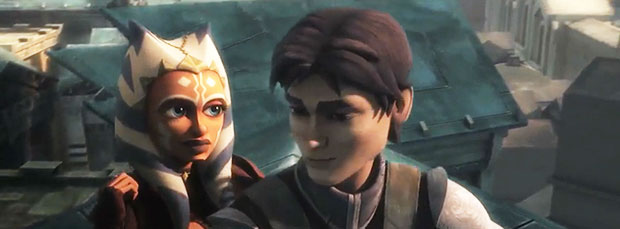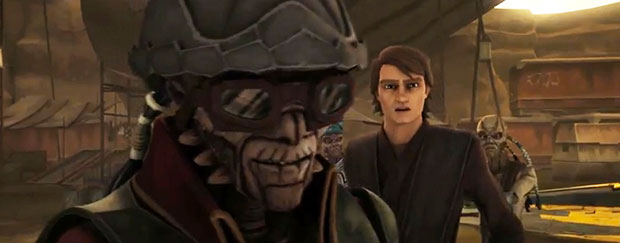 To quote Obi-Wan Kenobi, “Hello there!” I am Christian Blauvelt, and I will be your new guide to all things Star Wars. At Entertainment Weekly I became the holocron keeper, if you will, for any matters pertaining to that Galaxy Far, Far Away—including the new developments revealed by Lucasfilm Animation’s ongoing Cartoon Network series, Star Wars: The Clone Wars. If you’ve been watching The Clone Wars at all over the past few years, you’ll know that this show has matured beyond anyone’s wildest expectations since its 2008 debut. As such, I recapped the show for EW.com, and drew quite a following among those who like to parse the Star Wars canon for even the tiniest, hair-splitting details. Don’t know the difference between a Kowakian monkey lizard and Krayt dragon? Then I’m your geek! And now I’m bringing my Clone Wars recaps to Hollywood.com!
To quote Obi-Wan Kenobi, “Hello there!” I am Christian Blauvelt, and I will be your new guide to all things Star Wars. At Entertainment Weekly I became the holocron keeper, if you will, for any matters pertaining to that Galaxy Far, Far Away—including the new developments revealed by Lucasfilm Animation’s ongoing Cartoon Network series, Star Wars: The Clone Wars. If you’ve been watching The Clone Wars at all over the past few years, you’ll know that this show has matured beyond anyone’s wildest expectations since its 2008 debut. As such, I recapped the show for EW.com, and drew quite a following among those who like to parse the Star Wars canon for even the tiniest, hair-splitting details. Don’t know the difference between a Kowakian monkey lizard and Krayt dragon? Then I’m your geek! And now I’m bringing my Clone Wars recaps to Hollywood.com!
First up, this weekend’s phenomenal arc-capping installment, “Tipping Points.” Every season, The Clone Wars gives us one grueling, muck-and-grime military campaign, usually spread over four episodes. That’s exactly what we got from the Onderon arc–a microscopic look at the galactic conflict from the ground-up perspective of civilians-turned-soldiers fighting for their freedom. As much as I enjoy episodes featuring Rex, Cody, and other of the Republic’s fine clone troopers, I still prefer looking at this war from the perspective of people who weren’t born in a vat. Maybe it’s as simple as the fact that the clone troopers are professional soldiers, but, to me, it’s more interesting to focus on people like the rebels of Onderon who are actually fighting for a day when they won’t have to fight anymore. In short, the stakes are greater.
Last time we saw the rebels on Onderon, they had just rescued King Dendup from what would have been a nasty public execution. It was pretty thrilling, and I half expected rebel leader Steela to shout “Sanctuary! Sanctuary!” as she clutched the king, for full Victor Hugo-esque impact. Still, several questions kept nagging me about this rescue. Why didn’t the rebels also try to kidnap the Separatist-allied usurper, King Rash? Why didn’t they try to shoot and destroy the Seppie tactical droid, Kalani? And why does the true king, Dendup, sound so much like Palpatine? Does this mean he’s really evil too?
Actually, there’s at least a very good answer as to why they didn’t kidnap or kill King Rash. An answer that speaks to how sophisticated this show has become in demonstrating the intersection of politics and combat. Because of their thrilling rescue of King Dendup, there’s now rioting in the streets of capital city Iziz. That is, rioting against the government of the usurper Rash and his Separatist allies. It took an elaborate piece of heroic tactical theater to spur the people into action. Onderon is full of really, really apathetic folks, it seems, and if the rebels had done anything rash like kidnap Rash it may have spooked the populace into inertia. The ordinary Onderonian on the street might have thought the rebels to be no better than Rash’s administration if they had employed a similar tactic against him. It would have been a false equivalency for sure, but Steela and the rebel leaders have to factor in public perception when developing their strategy. That’s what I mean about how savvy and subtle The Clone Wars has become in showing aspects of the galactic conflict. Compare the Onderon arc in this regard to the Battle of Ryloth storyline in Season 1—where the Ryloth rebels just had to shoot their way to victory against their positively genocidal Separatist overlords—and you’ll see how far this show has come.
NEXT: The battle for King Dendup is over. The Battle for Onderon is about to begin. 
Recognizing her tremendous leadership ability, Dendup gave command of the Army to Steela. Steela, in turn, gave Lux a kiss. Oh, Ahsoka, your on-again, off-again relationship with Lux seems headed for permanent off-again status. But there was no time for anyone to make love under the dappled-green skies of Onderon. Kalani ordered a full-scale assault on the rebels’ mountain base. His secret weapon? New droid gunships that shoot bullets instead of lasers and possess powerful ray shields. The only time we’ve seen these before was in Revenge of the Sith when the Seppies used them against the Wookiees in the Battle of Kashyyyk. And for full Cylon-sinister effect, they even respond to Kalani’s orders with “By your command!”
Not gonna lie. The battle was very Avatar-y. But before you allege any copycatting afoot, consider that Onderon had been established as a jungle planet with flying-beast riders in the ’90s, years before James Cameron’s opus, in Kevin J. Anderson’s Tales of the Jedi comics.
Anyway, this fight wasn’t going well for the rebels. They had no defense against the droid gunships’ aerial assault. Obi-Wan even told Ahsoka that she should evacuate what forces she could if it looked like defeat was certain. The Republic just couldn’t afford to send in clone reinforcements.
If you think about it, this is the first time, really, that we’ve gotten a sense of how limited the Republic’s resources actually are. That initial order of 3 million clones from Kamino has stretched pretty far for the Grand Army of the Republic in terms of fighting battles on fronts all across the Galaxy. But there are limits. And the recognition of those limits is part of what lent this whole arc a new level of realism for the show. The Republic would certainly like to see Onderon back in the fold…but they need for the people of Onderon to want to rejoin the Republic as well, and to fight on their own to make that happen. Therefore, the Jedi can only serve as military advisers to the rebels, not actually fight the war for them outright. And maybe–just maybe–they would even help send arms to their allies through a third party.
Enter Hondo. The pirate seemed like the perfect third party for Anakin to employ to deliver rocket launchers to the rebels that would help pierce the gunships’ ray shields. Especially since Hondo owes the Jedi a debt for saving his leathery hide from the horned menace of Darth Maul and Savage Opress. So he fired up his starship and delivered the shoulder-fired missiles to the rebs, and even flirted a little bit with Steela! That lusty bastard. But at the first sign of blaster fire, off Hondo went: “Well, my work here is done.” With the rocket launchers, the rebels turned the tide. But only because of these new weapons in their arsenal. Another reason why the Battle of Onderon shows how smart and strategic The Clone Wars has become in its depiction of warfare–this isn’t just a laserfire vs. laserfire light-show anymore.
NEXT: Somebody becomes One with the Force. But I’m not going to turn to the Dark Side and spoil it for you before you click into the next page. I did enjoy that little bit of Luke and Han-style interplay between Ahsoka and Lux, when the latter responded to Ahsoka’s “Steela sure leads by example” with “What good will that do her if she gets herself killed?” Unfortunately, Lux’s quip turned genuinely prophetic just a moment later when Steela in fact did meet her end. Though she successfully rescued King Dendup from a posse of droids that were getting ready to push him over a cliff, it was Steela who found herself dangling off the edge when a gunship nearly crashed into them. A gunship that her own brother, Saw, had brought down. As her last act, Steela pushed the king to safety, but lost her footing and got only a tenuous grip on the cliff’s edge. Lux ran to her rescue but nearly fell over himself. Ahsoka then stepped in, but made the mistake of Force-lifting Lux, who wasn’t in as immediate of danger, out of the way first. Then when she tried to do the whole Yoda-style “Size Matters Not” thing and lift Steela, a laser blast from the downed gunship broke her concentration, and Steela fell to her death. But she had sacrificed herself to save the symbol of her planet’s hard-won freedom: King Dendup.
It was a powerful moment, and one that shows the real consequences of war. It isn’t just candy-colored laser battles designed to get kids to buy action figures. People can die, tragically and senselessly. The price of victory can be very high indeed. That’s what gives this show moral purpose and urgency–the very thing that makes it so unique among any animated TV series today. That’s why we’re recapping it on Hollywood.com.
The Seppies could possibly continue to root out the rebels…but it would take time. And Count Dooku is not a patient man. So he ordered Kalani to withdraw their remaining forces. He did just that, and cleaned up his last and biggest loose-end by casually shooting King Rash.
We were left with a full, Return of the King-style victory celebration as Dendup once again took up the throne that was rightfully his. Lux told Ahsoka that he planned to follow in his mother’s footsteps and represent Onderon in the Galactic Senate. He would steer his planet toward rejoining the Republic. It may be imperfect, it may even be outright corrupt, but at least it still allows for its representatives to try to make it a more perfect union. If it weren’t secretly ruled by a Sith Lord hellbent on plunging the Galaxy into darkness and tyranny, that is. But, hey, Lux doesn’t know that. Hindsight is 50/50, right?
Unfortunately, Ahsoka is now so uncertain about fighting this war that she’s even lost confidence in the purpose of the Republic. Meaning that she’s still not on the same page as Lux. They’ve swapped positions! These two will never be able to get together will they?
What did you think of the Onderon arc? Do you agree that it’s a prime example of the way this series has matured? Do you think Ahsoka really was as disillusioned by the Republic’s non-assistance during these episodes as I think she may be? And is there any chance for Lusoka?
See you next week!
More:
’Star Wars’ 35th Anniversary: 35 Changes from 1977 to 2012
’Star Wars’ Episodes II and III to be Re-Released in 3-D
From Our Partners:
 ’Bring It On’ Star Struck By Car and Killed
’Bring It On’ Star Struck By Car and Killed
(Celebuzz)
Kardashians Share Scary-Cute Childhood Halloween Pics
(Celebuzz)




